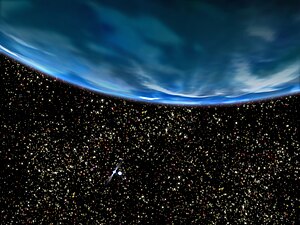PSR B1620-26 b
| Exoplanet | List of exoplanets | |
|---|---|---|
 |
||
| Parent star | ||
| Star | PSR B1620-26 AB | |
| Constellation | Scorpius | |
| Right ascension | (α) | 16h 23m 38s |
| Declination | (δ) | −26° 31′ 53″ |
| Apparent magnitude | (mV) | 24 |
| Distance | 12,400 ly (3,800 pc) |
|
| Spectral type | Pulsar / DB | |
| Mass | (m) | 1.35 / 0.34 M☉ |
| Radius | (r) | 0.00003 / 0.01 R☉ |
| Temperature | (T) | ≤300000 / ≤25200 K |
| Age | 13 Gyr | |
| Physical characteristics | ||
| Mass | (m) | 2.5 (± 1) MJ |
| Stellar flux | (F⊙) | 0.006⊕ |
| Temperature | (T) | 72 K (−201.2 °C; −330.1 °F) |
| Orbital elements | ||
| Semi-major axis | (a) | 23 AU |
| Eccentricity | (e) | low |
| Orbital period | (P) | 36,525 d (~100 y) |
| Inclination | (i) | 55° |
| Discovery information | ||
| Discovery date | May 30, 1993 (confirmed July 10, 2003) |
|
| Discoverer(s) | Backer et al. | |
| Discovery method | Pulsar timing | |
| Discovery site |
|
|
| Discovery status | Published | |
| Other designations | ||
|
Methuselah, PSR B1620-26 b, PSR J1623-2631 c
|
||
| Database references | ||
| Extrasolar Planets Encyclopaedia |
data | |
| SIMBAD | data | |
| Exoplanet Archive | data | |
| Open Exoplanet Catalogue | data | |
PSR B1620-26 b is an extrasolar planet located approximately 12,400 light-years away from Earth in the constellation of Scorpius. It bears the unofficial nicknames "Methuselah" and "the Genesis planet" due to its extreme age and a few popular sources refer to this object as "PSR B1620-26 c" (see below for discussion). The planet is in a circumbinary orbit around the two stars of PSR B1620-26 (which are a pulsar (PSR B1620-26 A) and a white dwarf (WD B1620-26)) and is the first circumbinary planet ever confirmed. It is also the first planet found in a globular cluster. The planet is one of the oldest known extrasolar planets, believed to be about 12.7 billion years old.
PSR B1620-26 b has a mass of 2.5 times that of Jupiter, and orbits at a distance of 23 AU (3.4 billion km), a little larger than the distance between Uranus and the Sun. Each orbit of the planet takes about 100 years.
The triple system is just outside the core of the globular cluster Messier 4. The age of the cluster has been estimated to be about 12.7 billion years, and because all stars in a cluster form at about the same time, and planets form together with their host stars, it is likely that PSR B1620-26 b is also about 12.7 billion years old. This is much older than any other known planet, and nearly three times as old as Earth. It has been undergoing many stages through its lifetime.
PSR B1620-26 b orbits a pair of stars. The primary star, PSR B1620-26, is a pulsar, a neutron star spinning at 100 revolutions per second, with a mass of 1.34 M☉, a likely radius of around 20 kilometers (0.00003 R☉) and a likely temperature less than or equal to 300,000 K. The second is a white dwarf with a mass of 0.34 M☉, a likely radius of around 0.01 R☉, and a likely temperature less than or equal to 25,200 K. These stars orbit each other at a distance of 1 AU about once every six months. The age of the system is 12.7 to 13 billion years old, making this one of the oldest binary stars known. In comparison, the Sun has an age of 4.6 billion years.
...
Wikipedia
